
Child Login
- Kindergarten
- Number charts
- Skip Counting
- Place Value
- Number Lines
- Subtraction
- Multiplication
- Word Problems
- Comparing Numbers
- Ordering Numbers
- Odd and Even
- Prime and Composite
- Roman Numerals
- Ordinal Numbers
- In and Out Boxes
- Number System Conversions
- More Number Sense Worksheets
- Size Comparison
- Measuring Length
- Metric Unit Conversion
- Customary Unit Conversion
- Temperature
- More Measurement Worksheets
- Writing Checks
- Profit and Loss
- Simple Interest
- Compound Interest
- Tally Marks
- Mean, Median, Mode, Range
- Mean Absolute Deviation
- Stem-and-leaf Plot
- Box-and-whisker Plot
- Permutation and Combination
- Probability
- Venn Diagram
- More Statistics Worksheets
- Shapes - 2D
- Shapes - 3D
- Lines, Rays and Line Segments
- Points, Lines and Planes
- Transformation
- Quadrilateral
- Ordered Pairs
- Midpoint Formula
- Distance Formula
- Parallel, Perpendicular and Intersecting Lines
- Scale Factor
- Surface Area
- Pythagorean Theorem
- More Geometry Worksheets
- Converting between Fractions and Decimals
- Significant Figures
- Convert between Fractions, Decimals, and Percents
- Proportions
- Direct and Inverse Variation
- Order of Operations
- Squaring Numbers
- Square Roots
- Scientific Notations
- Speed, Distance, and Time
- Absolute Value
- More Pre-Algebra Worksheets
- Translating Algebraic Phrases
- Evaluating Algebraic Expressions
- Simplifying Algebraic Expressions
- Algebraic Identities
- Quadratic Equations
- Systems of Equations
- Polynomials
- Inequalities
- Sequence and Series
- Complex Numbers
- More Algebra Worksheets
- Trigonometry
- Math Workbooks
- English Language Arts
- Summer Review Packets
- Social Studies
- Holidays and Events
- Worksheets >
- Geometry >

Symmetry Worksheets
Symmetry worksheets consist of a variety of skills for children in grade 1 through grade 5 to understand the lines of symmetry in different shapes. Printable exercises to identify and draw the lines of symmetry, complete the shapes, count the lines of symmetry in each shape, to identify symmetrical or asymmetrical shapes and to determine the perimeter of shapes are given here for practice. Begin your practice with our free symmetry worksheets!
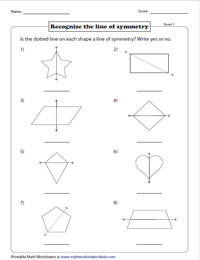
Recognizing Lines of Symmetry
Each symmetry worksheet pdf here shows eight different shapes through which a dotted line is drawn. Identify if the dotted line is a line of symmetry.
- Download the set
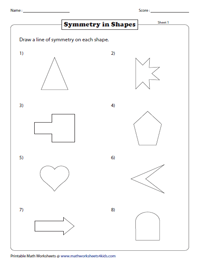
Drawing a Line of Symmetry: Shapes
Three exclusive worksheets to identify and draw a line of symmetry on each shape are given here.
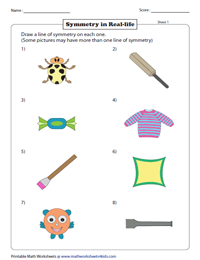
Drawing a Line of Symmetry: Real-Life Objects
Draw a line of symmetry for each real-life objects. Some objects may have more than one line of symmetry.

Lines of Symmetry: More than One Line
Shapes with more than one line of symmetry are given in these pdf worksheets. Determine and draw lines of symmetry on each shape and write down the number of lines of symmetry seen.
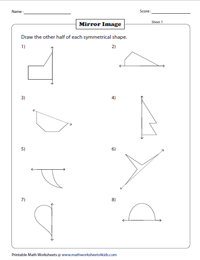
Complete the Mirror Image: Standard
One-half of symmetrical shapes are shown. Task grade 2 and grade 3 kids to draw the other half of the mirror image.
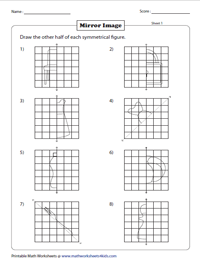
Complete the Mirror Image: Grid
One-half of real-life objects are drawn in the grids. Complete the second half of each symmetrical shape and solve the pdf worksheets.
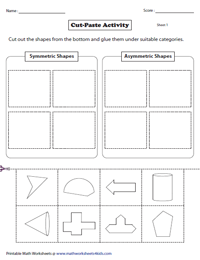
Cut-Paste Activity: Symmetric / Asymmetric
Cut out each shape from the bottom of these printable worksheets for 1st grade and 2nd grade kids and paste them in the appropriate category (symmetric or asymmetric shapes).
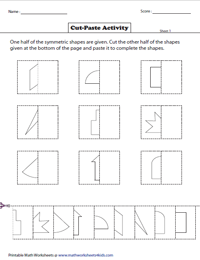
Cut-Paste Activity: Complete the Shape
A symmetrical half of the shapes are shown. The other half of each shape is given below. Cut out the other half and paste them to complete the shape.
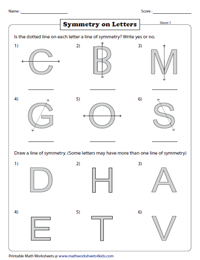
Symmetry on English Letters
Grade 4 children identify if the English letters shown are cut at the line of symmetry in part 1. Draw lines of symmetry on the given English letters in part 2.
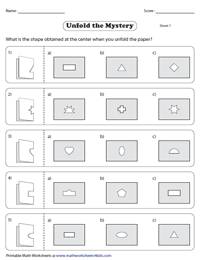
Unfold the Mystery
Each folded paper has a cutout region. Choose the exact shape obtained at the center when the paper is unfolded.
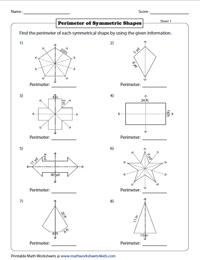
Perimeter of Symmetrical Shapes
Each printable worksheet shows eight symmetrical shapes with all the possible lines of symmetry. Students in 3rd grade, 4th grade, and 5th grade need to find the perimeter of each symmetrical shape using the information given.
Related Worksheets
» Slide, Flip and Turn
» Rotation
» Translation
» Reflection
Become a Member
Membership Information
Privacy Policy
What's New?
Printing Help
Testimonial
Copyright © 2024 - Math Worksheets 4 Kids
This is a members-only feature!

- Home |
- About |
- Contact Us |
- Privacy |
- Newsletter |
- Shop |
- 🔍 Search Site
- Easter Color By Number Sheets
- Printable Easter Dot to Dot
- Easter Worksheets for kids
- Kindergarten
- All Generated Sheets
- Place Value Generated Sheets
- Addition Generated Sheets
- Subtraction Generated Sheets
- Multiplication Generated Sheets
- Division Generated Sheets
- Money Generated Sheets
- Negative Numbers Generated Sheets
- Fraction Generated Sheets
- Place Value Zones
- Number Bonds
- Addition & Subtraction
- Times Tables
- Fraction & Percent Zones
- All Calculators
- Fraction Calculators
- Percent calculators
- Area & Volume Calculators
- Age Calculator
- Height Calculator
- Roman Numeral Calculator
- Coloring Pages
- Fun Math Sheets
- Math Puzzles
- Mental Math Sheets
- Online Times Tables
- Online Addition & Subtraction
- Math Grab Packs
- All Math Quizzes
- 1st Grade Quizzes
- 2nd Grade Quizzes
- 3rd Grade Quizzes
- 4th Grade Quizzes
- 5th Grade Quizzes
- 6th Grade Math Quizzes
- Place Value
- Rounding Numbers
- Comparing Numbers
- Number Lines
- Prime Numbers
- Negative Numbers
- Roman Numerals
- Subtraction
- Add & Subtract
- Multiplication
- Fraction Worksheets
- Learning Fractions
- Fraction Printables
- Percent Worksheets & Help
- All Geometry
- 2d Shapes Worksheets
- 3d Shapes Worksheets
- Shape Properties
- Geometry Cheat Sheets
- Printable Shapes
- Coordinates
- Measurement
- Math Conversion
- Statistics Worksheets
- Bar Graph Worksheets
- Venn Diagrams
- All Word Problems
- Finding all possibilities
- Logic Problems
- Ratio Word Problems
- All UK Maths Sheets
- Year 1 Maths Worksheets
- Year 2 Maths Worksheets
- Year 3 Maths Worksheets
- Year 4 Maths Worksheets
- Year 5 Maths Worksheets
- Year 6 Maths Worksheets
- All AU Maths Sheets
- Kindergarten Maths Australia
- Year 1 Maths Australia
- Year 2 Maths Australia
- Year 3 Maths Australia
- Year 4 Maths Australia
- Year 5 Maths Australia
- Meet the Sallies
- Certificates
Symmetry Worksheets Line Symmetry Easier
Welcome to the Math Salamanders Line Symmetry Worksheets page. Here you will find a range of free printable symmetry worksheets, which will help your child to practice their reflecting and flipping skills.
For full functionality of this site it is necessary to enable JavaScript.
Here are the instructions how to enable JavaScript in your web browser .
Symmetry Help
The Math Salamanders have a large bank of free printable symmetry worksheets. Each symmetry sheet comes complete with answers for support.
Handy Hints
Each point or block that has been reflected must remain the same distance from the mirror line as the original point. So if point A is 3 squares away from the mirror line, then the reflection of point A must also be 3 squares away.
When reflecting a shape, look at the corners of the shape and reflect each corner first as a dot in the mirror line. The dots can then be joined up (in the correct order!)
For lines of symmetry at angles of 45°, it is often better to rotate your paper so that the line of symmetry is vertical or horizontal, and the rest of the paper is at an angle.
The basis and understanding of symmetry starts at about Grade 2, and then develops further in Grades 3,4 and 5.
Line Symmetry Worksheets
On this webpage you will find our range of line symmetry sheets for kids.
The sheets have been carefully graded with the easier sheets coming first. The first 3 worksheets involve only horizontal and vertical lines only. The next 3 worksheets involve reflecting diagonal lines as well.
There are also some templates at the end of this section for you to create your own shapes for your child to reflect, or, even better, for your child to create their own symmetric patterns!
Using these sheets will help your child to:
- learn to reflect a shape in a vertical or horizontal mirror line;
- learn to reflect a shape in both a vertical and horizontal mirror line;
Reflecting in 1 mirror line
Horizontal and vertical lines only.
- Line Symmetry 1
- PDF version
- Line Symmetry 2
- Line Symmetry 3
- Line Symmetry 4
- Line Symmetry 5
- Line Symmetry 6
Reflecting in Diagonal mirror lines
- Line Symmetry 9
- Line Symmetry 10
Reflecting in vertical, horizontal and diagonal lines
- Line Symmetry 11
Reflecting in 2 mirror lines
- Line Symmetry 7
- Sheet 7 Answers
- Line Symmetry 8
- Sheet 8 Answers
Reflecting in vertical and horizontal or 2 diagonal lines
- Line Symmetry 12
Line Symmetry templates
- Line Symmetry Template 1
- Line Symmetry Template 2
- Line Symmetry Template 3
- Line Symmetry Template 4
- Line Symmetry Template 5
- Line Symmetry Template 6
Looking for something harder?
Here you will find a range of line symmetry activity sheets with one or two mirror lines.
The sheets in this section are similar to those on this page, but are more complicated and at a harder level.
- Harder Symmetry Activities
More Recommended Math Worksheets
Take a look at some more of our worksheets similar to these.
Block Symmetry Worksheets
Here you will find a range of symmetry worksheets reflecting blocks instead of lines.
These sheets are at an easier level than the ones on this page.
- Symmetry Worksheets - Block Symmetry
- Explore 2d Shapes Worksheets
Looking for some geometry worksheets to get children thinking and reasoning about 2d shapes?
The shapes on this page are all about children really understanding what 2d shapes are all about, and using their reasoning skills to justify their thinking.
- know the properties of a range of 2d shapes;
- recognise that some shapes can also be described as being other shapes; e.g. a square is also a rhombus;
- recognise and understand right angles, parallel lines, lines of symmetry;
- develop their geometric reasoning skills.
Coordinate Sheets
Here is our collection of printable coordinate plane grids and coordinate worksheets.
Using these fun coordinate sheets is a great way to learn math in an enjoyable way.
- plot and write coordinates.
- Coordinate Plane Grid templates
- Coordinate Worksheets (1st Quadrant)
- Coordinate Plane Worksheets (All 4 Quadrants)
Captain Recommends

Have a look at these online symmetry games - a great way to learn symmetry and get instant feedback!
- Softschools Symmetry Game
- Sheppard Software Symmetry Activities
How to Print or Save these sheets 🖶
Need help with printing or saving? Follow these 3 steps to get your worksheets printed perfectly!
- How to Print support
Subscribe to Math Salamanders News
Sign up for our newsletter to get free math support delivered to your inbox each month. Plus, get a seasonal math grab pack included for free!

- Newsletter Signup
Return to Geometry Section
Return from Symmetry Worksheets to Math Salamanders Homepage
Math-Salamanders.com
The Math Salamanders hope you enjoy using these free printable Math worksheets and all our other Math games and resources.
We welcome any comments about our site or worksheets on the Facebook comments box at the bottom of every page.
New! Comments
TOP OF PAGE
© 2010-2024 Math Salamanders Limited. All Rights Reserved.
- Privacy Policy
- Copyright Policy
High Impact Tutoring Built By Math Experts
Personalized standards-aligned one-on-one math tutoring for schools and districts
In order to access this I need to be confident with:
Lines of Symmetry
Lines of symmetry
Here you will learn about lines of symmetry, including symmetry properties within polygons, angle properties, and symmetry of different line graphs.
Students first learn about line symmetry in grade 4 with their work with 2D shapes in geometry.
What are lines of symmetry?
Lines of symmetry are straight lines that divide a shape into two equal parts, where one part is an exact reflection or mirror image of the other.
In geometry, many 2D shapes have line symmetry.
For example,
3 lines of symmetry | 4 lines of symmetry | 2 lines of symmetry | 6 lines of symmetry |
Line symmetry can be seen in nature.

Line symmetry can be seen in art.
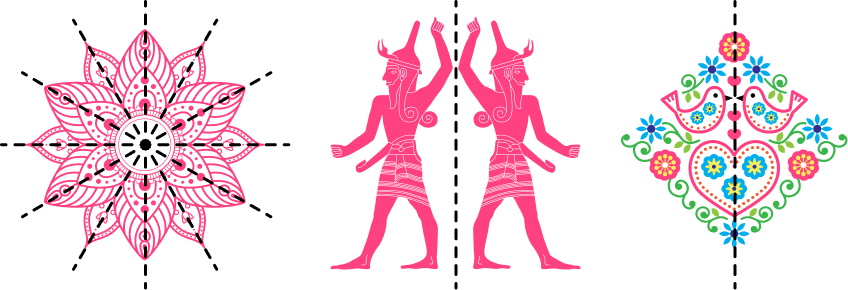
Lines of symmetry in regular shapes
Regular polygons are polygons that have equal side lengths and equal angle measures.
3 lines of symmetry Notice how each line of symmetry can be a fold line. |
4 lines of symmetry Notice how each line of symmetry can be a fold line. |
5 lines of symmetry Notice how each line of symmetry can be a fold line. |
6 lines of symmetry Notice how each line of symmetry can be a fold line. |
Notice how the number of lines of symmetry in these regular polygons is equal to the number of sides and angles the polygons have.
All regular polygons share the property that the number of sides is equal to the number of lines of symmetry.
![homework of symmetry [FREE] 2D Shape Worksheet (Grade 2 to 4)](https://thirdspacelearning.com/wp-content/uploads/2023/07/2D-shapes-check-for-understanding-quiz-listing-image.png)
[FREE] 2D Shape Worksheet (Grade 2 to 4)
Use this quiz to check your grade 2 – 4 students’ understanding of 2D shape. 10+ questions with answers covering a range of 2nd, 3rd and 4th grade 2D shape topics to identify areas of strength and support!
Lines of symmetry in irregular shapes
Irregular polygons are polygons that do not have all equal angles and all equal side lengths. However, they can have line symmetry.
For example, these irregular polygons have line symmetry.
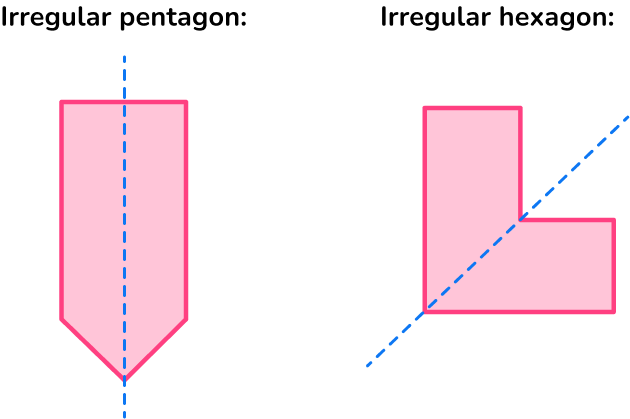
Let’s look at different shapes (specifically quadrilaterals) and their number of lines of symmetry.
| of Symmetry | ||
|---|---|---|
| Square | 4 | |
| Rectangle | 2 | |
| Parallelogram | 0 | |
| Rhombus | 2 | |
| Kite | 1 | |
| Trapezoid | 0 | |
| Isosceles Trapezoid | 1 | |
| Irregular | 0 |
Lines of symmetry in circles
The diameter of a circle splits the circle into two equal sized half circles, or semicircles. Think of the diameter as the line of reflection.
A circle can be folded in-half many ways, meaning that there are an infinite number of lines of symmetry.

Common Core State Standards
How does this apply to 4th grade math?
- Grade 4: Geometry (4.G.A.3) Recognize a line of symmetry for a two-dimensional figure as a line across the figure such that the figure can be folded along the line into matching parts. Identify line-symmetric figures and draw lines of symmetry.
How to identify lines of symmetry
In order to draw/identify lines of symmetry:
Locate the center of the 2D shape.
Draw a vertical line through the center and check for line symmetry.
Draw a horizontal line through the marked center and check for line symmetry.
- Draw a line from each vertex through the center and check for symmetry.
State the number of lines of symmetry.
Lines of symmetry examples
Example 1: regular shapes.
How many lines of symmetry does the equilateral triangle have?
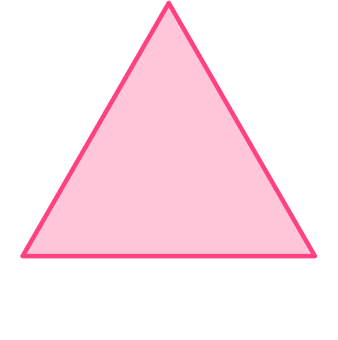
2 Draw a vertical line through the center and check for line symmetry.
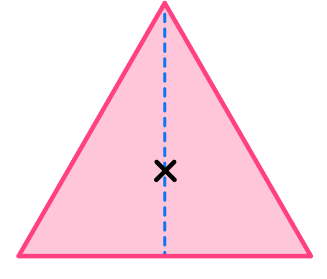
The vertical line through the center is a line of symmetry dividing the triangle into two equal halves that are mirror images of each other. Notice that it can be a fold line.
3 Draw a horizontal line through the marked center and check for line symmetry.
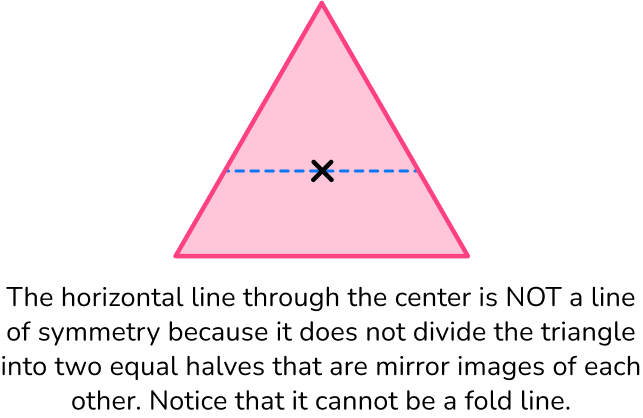
4 Draw a line from each vertex through the center and check for line symmetry.
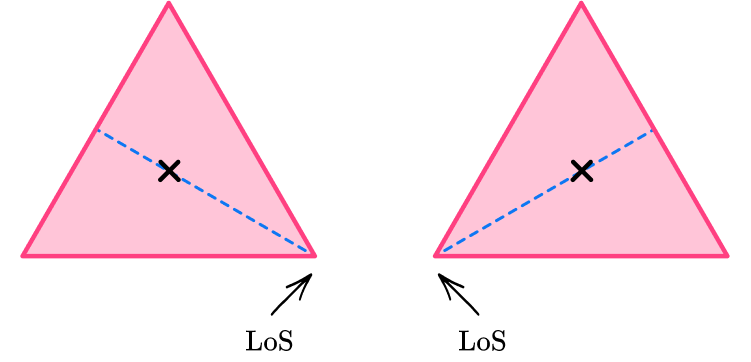
5 State the number of lines of symmetry.
The equilateral triangle has 3 lines of symmetry. An equilateral triangle has 3 equal sides and 3 equal angles, so it will have 3 lines of symmetry.
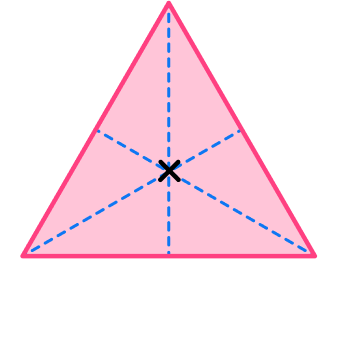
Example 2: the regular pentagon
How many lines of symmetry does the regular pentagon have?

The vertical line is a line of symmetry because it divides the regular pentagon into two equal halves that are mirror images of each other.
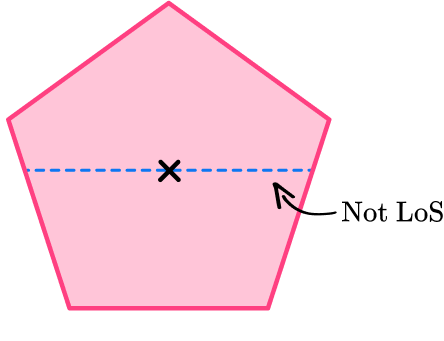
The horizontal line is NOT a line of symmetry because it does not divide the regular pentagon into two equal halves that are mirror images of each other.
Draw a line from each vertex through the center and check for line symmetry.

A regular pentagon has 5 lines of symmetry. A regular pentagon has 5 equal sides and 5 equal angles, so it will have 5 lines of symmetry.
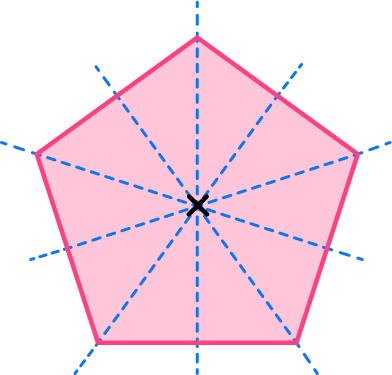
Example 3: irregular shapes
How many lines of symmetry does the trapezoid have?

The vertical line is a line of symmetry because it divides the trapezoid into two equal halves that are mirror images of each other.
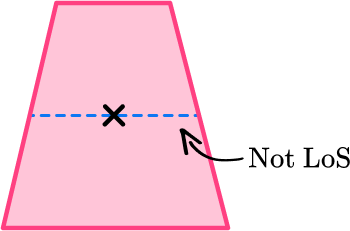
The horizontal line is NOT a line of symmetry because it does not divide the trapezoid into two equal halves that are mirror images of each other.
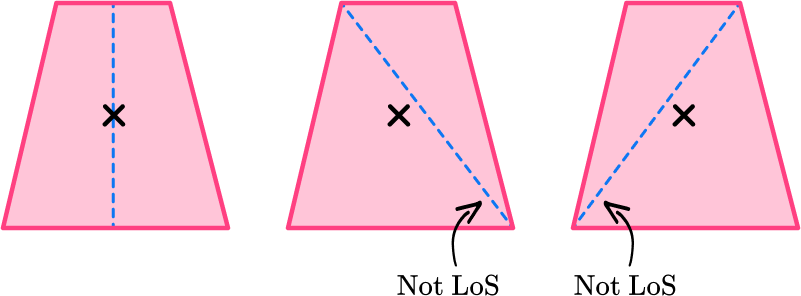
The trapezoid has one line of symmetry.
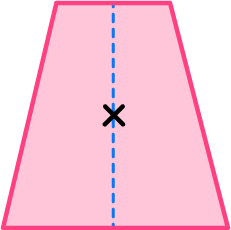
Example 4: irregular shapes
How many lines of symmetry does the irregular hexagon have?

The vertical line is a line of symmetry because it divides the irregular hexagon into two equal halves that are mirror images.

The horizontal line is a line of symmetry because it divides the irregular hexagon into two equal halves that are mirror images.
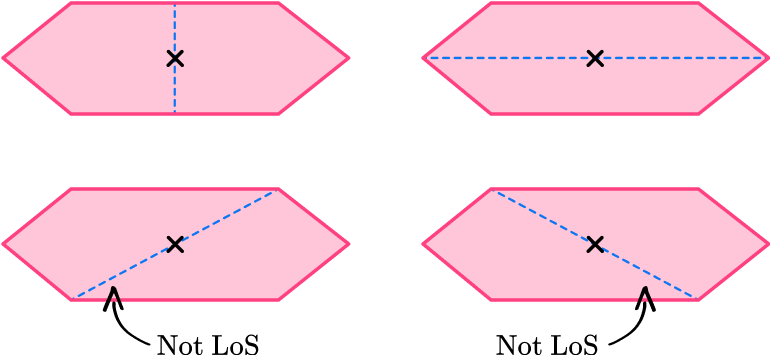
The irregular hexagon has two lines of symmetry.
Example 5: irregular shapes
How many lines of symmetry does the parallelogram have?

The vertical line is NOT a line of symmetry because it does not divide the parallelogram into two equal halves that are mirror images of each other.
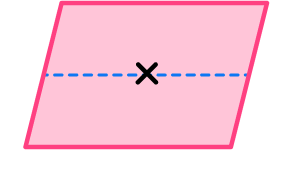
The horizontal line is NOT a line of symmetry because it does not divide the parallelogram into two equal halves that are mirror images of each other.
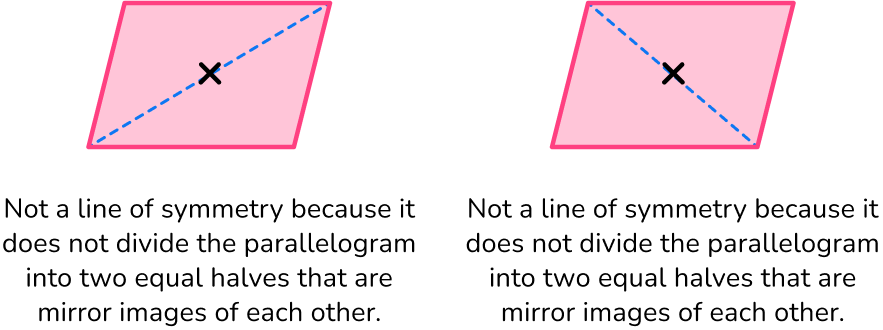
The parallelogram does not have any lines of symmetry.
Example 6: irregular shapes
How many lines of symmetry does the shape have?

The vertical line is a line of symmetry because it divides the shape into two equal halves that are mirror images of each other.
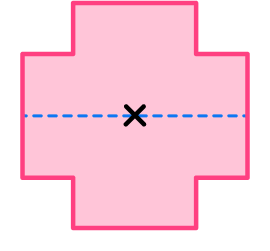
The horizontal line is a line of symmetry because it divides the shape into two equal halves that are mirror images of each other.
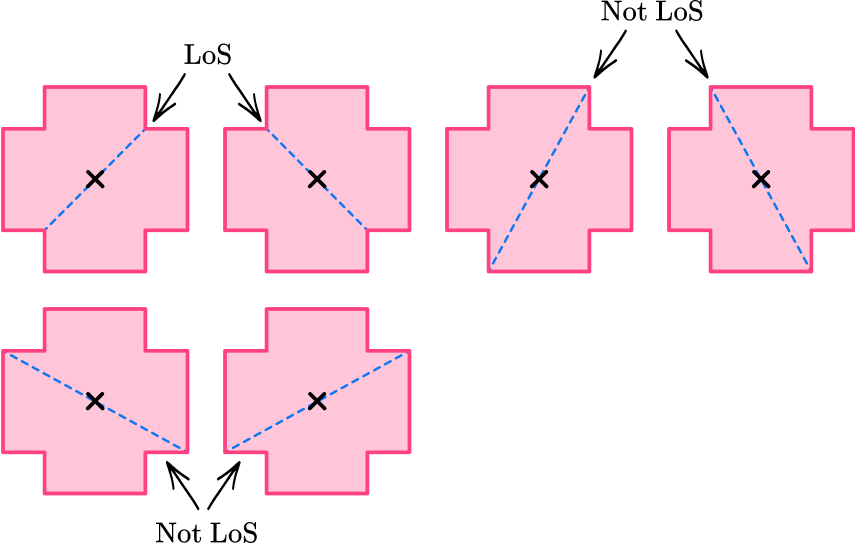
The irregular shape has 4 lines of symmetry.
Teaching tips for lines of symmetry
- Use hands on manipulatives to help students gain understanding of lines of symmetry.
- Infuse creative activities such as origami so that students can build understanding through fun learning tasks.
Easy mistakes to make

- Thinking that all quadrilaterals have \bf{4} lines of symmetry The only quadrilateral with 4 lines of symmetry is a square because it is a regular polygon. The other quadrilaterals are not regular polygons so do not have 4 lines of symmetry.
- The number of sides always \textbf{=} the number of lines of symmetry Although this is true for regular shapes, it is not true for all shapes.
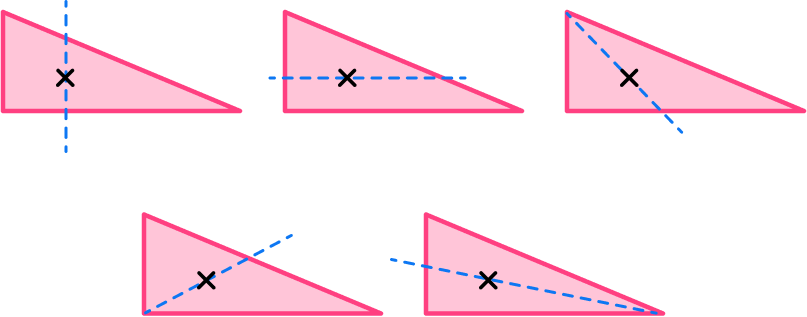
Related symmetry lessons
- Rational symmetry
Practice lines of symmetry questions
1. Find the number of lines of symmetry for the regular hexagon below.

Regular polygons have the same number of lines of symmetry as the number of sides that they have.
A hexagon has 6 sides so it has 6 lines of symmetry.

Marking the center, there are 6 lines that can be drawn through the center that cut the regular hexagon into equal halves that are mirror images of each other.
2. Find the number of lines of symmetry for the rectangle below.

After marking the center, the vertical line through the center and the horizontal line through the center are the only lines of symmetry.
Any other line drawn through the center will not result in the shape being divided into two equal halves that are mirror images.
3. Find the number of lines of symmetry for the kite below.

After marking the center, the only line of symmetry is the horizontal line.
There is no other line that can be drawn through the center that will divide the shape into two equal parts that are mirror images of each other.

4. Find the number of lines of symmetry for the irregular hexagon below.

After marking the center, the lines of symmetry are the vertical line through the center and the horizontal line through the center.
No other lines through the center will divide the shape into two equal parts that are mirror images of each other.
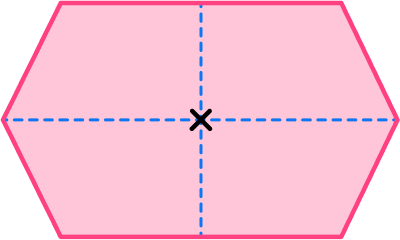
5. How many lines of symmetry does the smiley have?

Circles have an infinite amount of lines of symmetry. However, you have to take the eyes and mouth into account when figuring out the lines of symmetry.
There is only one line of symmetry vertically down the face that will divide the smiley face into two equal mirror images of each other.

6. How many lines of symmetry does the photo have?

The photo has two lines of symmetry, one that is horizontal through the center and the other that is vertical through the center.
There are no other lines that can be drawn that divides the photo into two equal halves that are mirror images of each other.
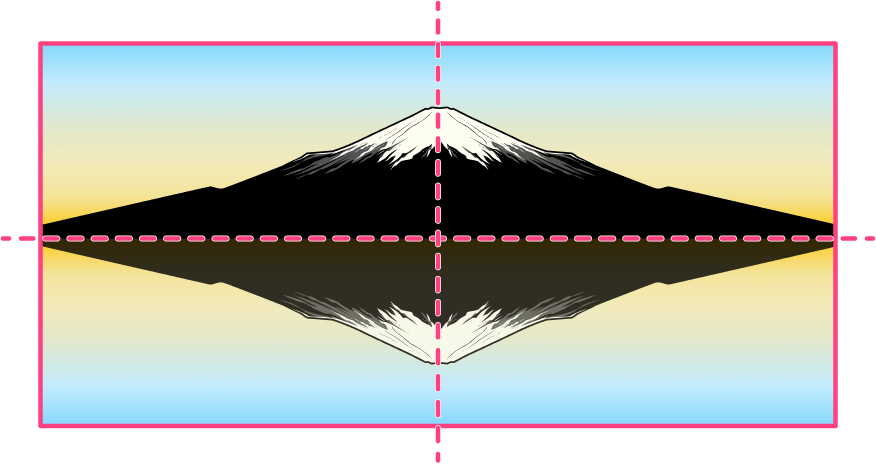
Lines of symmetry FAQs
There are two types of symmetry. Line symmetry is drawing a line through the center of a figure where both halves are mirror images of each other. Rotational symmetry involves turning a shape and determining how many times the shape appears as its original in one complete 360^{\circ} turn.
In algebra, you will learn about quadratic functions whose graph is a parabola. The parabola has a line going through the center that divides it into identical halves, which is the axis of symmetry. It is also the line of symmetry of the parabola.
No, a scalene triangle does not have any lines of symmetry. Meaning there are no imaginary lines or mirror lines that can be drawn through the center of the triangle, where one half is equal and the mirror image of the other half. Isosceles triangles have only one line of symmetry. Equilateral triangles are regular polygons, so they have 3 lines of symmetry.
Yes, regular polygons are symmetrical shapes because they have equal sides and equal angles. They have line symmetry and rotational symmetry.
Congruent means identical in shape and size. When drawing a dotted line representing line symmetry, each half of the shape is congruent.
The next lessons are
- Angles in polygons
- Congruence and similarity
- Transformations
Still stuck?
At Third Space Learning, we specialize in helping teachers and school leaders to provide personalized math support for more of their students through high-quality, online one-on-one math tutoring delivered by subject experts.
Each week, our tutors support thousands of students who are at risk of not meeting their grade-level expectations, and help accelerate their progress and boost their confidence.

Find out how we can help your students achieve success with our math tutoring programs .
[FREE] Common Core Practice Tests (Grades 3 to 6)
Prepare for math tests in your state with these Grade 3 to Grade 6 practice assessments for Common Core and state equivalents.
40 multiple choice questions and detailed answers to support test prep, created by US math experts covering a range of topics!
Privacy Overview

Addition (Basic)
Addition (Multi-Digit)
Algebra & Pre-Algebra
Comparing Numbers
Daily Math Review
Division (Basic)
Division (Long Division)
Hundreds Charts
Measurement
Multiplication (Basic)
Multiplication (Multi-Digit)
Order of Operations
Place Value
Probability
Skip Counting
Subtraction
Telling Time
Word Problems (Daily)
More Math Worksheets
Reading Comprehension
Reading Comprehension Gr. 1
Reading Comprehension Gr. 2
Reading Comprehension Gr. 3
Reading Comprehension Gr. 4
Reading Comprehension Gr. 5
Reading Comprehension Gr. 6
Reading & Writing
Reading Worksheets
Cause & Effect
Fact & Opinion
Fix the Sentences
Graphic Organizers
Synonyms & Antonyms
Writing Prompts
Writing Story Pictures
Writing Worksheets
More ELA Worksheets
Consonant Sounds
Vowel Sounds
Consonant Blends
Consonant Digraphs
Word Families
More Phonics Worksheets
Early Literacy
Build Sentences
Sight Word Units
Sight Words (Individual)
More Early Literacy
Punctuation
Subjects and Predicates
More Grammar Worksheets
Spelling Lists
Spelling Grade 1
Spelling Grade 2
Spelling Grade 3
Spelling Grade 4
Spelling Grade 5
Spelling Grade 6
More Spelling Worksheets
Chapter Books
Charlotte's Web
Magic Tree House #1
Boxcar Children
More Literacy Units
Animal (Vertebrate) Groups
Butterfly Life Cycle
Electricity
Matter (Solid, Liquid, Gas)
Simple Machines
Space - Solar System
More Science Worksheets
Social Studies
Maps (Geography)
Maps (Map Skills)
More Social Studies
Mother's Day
Father's Day
More Holiday Worksheets
Puzzles & Brain Teasers
Brain Teasers
Logic: Addition Squares
Mystery Graph Pictures
Number Detective
Lost in the USA
More Thinking Puzzles
Teacher Helpers
Teaching Tools
Award Certificates
More Teacher Helpers
Pre-K and Kindergarten
Alphabet (ABCs)
Numbers and Counting
Shapes (Basic)
More Kindergarten
Worksheet Generator
Word Search Generator
Multiple Choice Generator
Fill-in-the-Blanks Generator
More Generator Tools
Full Website Index
Symmetry Worksheets
Printable practice worksheets to help you teach and review symmetry. Includes worksheets the require students to draw lines of symmetry, determine which pictures are symmetrical, and design symmetrical illustrations.

Logged in members can use the Super Teacher Worksheets filing cabinet to save their favorite worksheets.
Quickly access your most used files AND your custom generated worksheets!
Please login to your account or become a member and join our community today to utilize this helpful feature.

Also on Super Teacher Worksheets...
Learn about lines, angles, polygons, solid shapes, circles, and more!
Practice reading clocks and telling time.
Round numbers to the nearest ten, hundred, and thousand.
Pictures of Our Worksheets
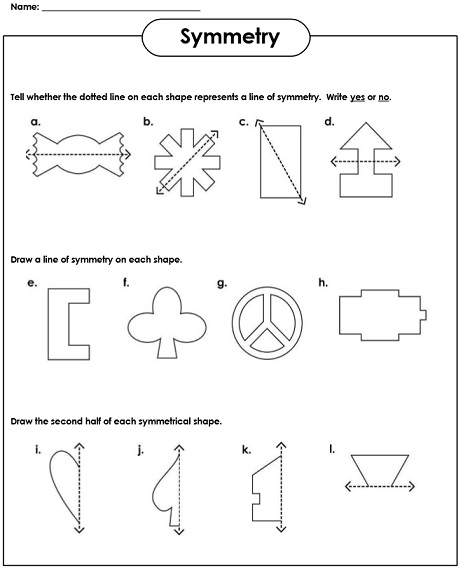
PDF with answer key:
PDF no answer key:
7 Superb Symmetry Activities (with a FREEBIE!)
- Freebies , Math , Planning
In the hustle and bustle of the upper elementary classroom, where every moment is precious and every standard is vital, it can be difficult to give every last educational concept the attention it deserves. This is especially true when a concept only has one or two standards addressing it. If it only has one standard in all of upper elementary, then it must not be too important, right?
… Or, maybe, the concept is just SO important that it only needs to be covered once to make a lasting impact on your kiddos! That’s what I’m choosing to believe, anyway, when it comes to symmetry. Maybe it’s my artistic side speaking, but I absolutely LOVE symmetry, and it actually hurts my feelings that this geometry concept doesn’t always get the attention it deserves.
For instance, when conducting my research for this blog post, I noticed a severe lack of educational resources and ideas that align with the Common Core State Standard 4.G.3 : “Recognize a line of symmetry for a two-dimensional figure as a line across the figure such that the figure can be folded along the line into matching parts. Identify line-symmetric figures and draw lines of symmetry.”
It’s obviously important to ensure your kiddos are meeting CCSS, but once that goal is met, symmetry can sometimes fall to the wayside. It’s understandable, since there are simply SO MANY standards to get to, but symmetry really is important in its own right!
Let’s check out why it’s vital to students’ mathematical careers, then we’ll dive into seven symmetry activities that are sure to supplement your geometry lessons… Complete with a FREEBIE at the end!
Why Bother with Symmetry?
It’s not just important to cover symmetry in preparation for testing. Exploring symmetry helps students build fluency in math by reinforcing key concepts like congruence, transformations, and geometric properties. By working through engaging, hands-on symmetry activities and discussions, students develop a stronger understanding of math principles and develop fluency in applying them to new situations.
In addition, building a strong foundation in symmetry also helps students develop spatial reasoning skills, which are super important for understanding tougher geometric concepts and spatial relationships down the line. It’s a great way to help students learn to visualize shapes, identify patterns, and make predictions.
There’s also plenty of symmetry to be found in nature, too! This is certainly a neat way to make real-world connections with your kiddos, but beyond that, it also provides you with a great opportunity for an integrated curriculum with Earth science… Which, as you know, is like, my favorite thing ever . 😉
Okay, I think I’ve made my point. Let’s jump right into the activities!

Seven Symmetry Activities
1. symmetry art swap.
For this activity, you’ll want to provide individuals with graph paper and art supplies. Every student will begin by creating a “line of symmetry,” preferably horizontal or vertical to begin with, through the center of the page. Then, they can create a geometric design of their liking on ONE side of the mirror line. Of course, students should be given free agency with their designs, but you may want to encourage simpler designs to start with to allow kiddos to get the hang of the concept of symmetry.
Once students have created their designs on one side of the mirror line, have them swap their graph paper with a partner. The partner should then try to finish the design on the other side of the symmetry line! Since this is a pretty quick activity, I recommend having students repeat these steps a few more times. They can experiment with more complex designs and even add colors to be mirrored!
It’s not a bad idea either to encourage kiddos to find NEW partners every time, too. You don’t want them sticking to only their best friend—switch it up so everyone gets a diverse experience.
These symmetry art pieces can be shown off in the classroom or even a hallway bulletin board for a cute, easy display. Kiddos love showing off their work, and a splash of color in the halls always does wonders to brighten spirits!
2. Symmetry Manipulatives
Similar to the art swap above, this is another way for students to express their creativity by creating symmetrical designs. This time, though, they can only use manipulatives, such as pattern blocks, tangrams, or other physical geometrical shapes. It’s a bit more challenging than the art swap, since they don’t have complete freedom over the design; rather, they’re bound by the dimensions of the trapezoids and rhombuses and squares!
For this activity, have students sit across from one another and try to replicate one another’s designs using the pattern blocks. They should notice that the design is “mirrored” across a horizontal line of symmetry between them. Kiddos can even take turns making designs and creating a symmetrical version.

3. Symmetry Construction
If someone had told me back at university just how much I’d end up advocating for the use of toothpicks in the classroom, I would never have believed them… But, goodness, there’s no denying their myriad of uses! From fencing in animals to investigating camouflage , toothpicks are practically the backbone of hands-on activities.
And, as you’re sure to see, geometry is no exception! For this activity, have students use toothpicks to create symmetrical shapes. They can connect the toothpicks (or even popsicle sticks, if you prefer) at their endpoints to form geometric shapes, then identify and label the lines of symmetry within their creations—or you can have a partner do that part.
Challenge students to see how many lines of symmetry they can create within one design! Of course, in that case, you may want to ban circles… That might be a little too easy. 😉
4. Symmetry Scavenger Hunt
Listen, I know I recommend scavenger hunts, like, ALL the time, but you can’t blame me: they’re a perfect way to get students up and moving around, keeping them engaged while staying on-task!
For this activity, you’ll encourage kiddos to engage with a geometric scavenger hunt around the classroom, encouraging them to search for symmetrical objects or patterns. If you’d like, you can set out symmetrical pictures or the like ahead of time, but that’s not totally necessary; most classrooms are already chock-full of symmetry if you take the time to look!
Have students record their findings in a notebook or on a piece of paper as they move through the scavenger hunt. They should sketch all of the items they discover that are symmetrical and draw its lines of symmetry—for instance, they could draw the top-down view of a desk and include all of its symmetrical lines.
Once students have had enough time to scan the entire room, reconvene as a class and discuss their findings. Encourage productive discussion by asking questions, such as “Which objects have the most symmetrical lines?” and even deeper critical-thinking questions like “Would the entire classroom be symmetrical if it were mirrored? Why or why not?”
5. Symmetry Nature Walk
What’s this? Another opportunity to integrate curriculum? You got it! Add a helping of Earth science to your geometry unit by bringing students outside to make mathematical observations about nature.
Before heading outside, however, it’s time for a brainstorm sesh. As a class, discuss what kinds of symmetrical objects you may find outside! This is a good way to get students visualizing symmetry, which is a vital step to fully grasping geometry.
Then… Go outside! Just like with the scavenger hunt, have kiddos bring along paper in order to sketch images of the symmetrical objects they find along with their lines of symmetry. Some common examples they may find outside are leaves, flowers, and even insects!

After the adventure, reconvene in the classroom and have students share their findings. Ask more questions, like which objects outside had the most lines of symmetry, if there were any perfectly symmetrical objects (like circles) and so on.
This is a great opportunity for critical thinking, too! What observations can your students make about symmetry in nature? Is it common? Lots of wildlife is symmetrical to some degree, like humans. Why do they think this is? There are no right or wrong answers; the exercise is simply meant to get students thinking and visualizing!
6. Symmetry Stations
Next up, set up several different stations around the room that each center around a type of geometric shape, such as circles and ovals, triangles, parallelograms, and other shapes, like hearts, crosses, arrows, stars, and so on.
Each station should have around five “cards” each that have a different shape relevant to the station’s theme. For example, the triangle station should feature five different triangles of different sizes, each with varying amounts of lines of symmetry.
At each station, students should sketch the shapes on the cards on their own personal graph paper. Then, they can fold their paper to find lines of symmetry! The folding is an important part—not just because it’s hands-on, but also because it ensures that students are fully grasping the concept, specifically as it’s cited in CCSS 4.G.3 : “Recognize a line of symmetry for a two-dimensional figure as a line across the figure such that the figure can be folded along the line into matching parts.”
Students should work together with groups or partners and go through all of the stations until they have “dissected” all of the cards at each center. Then, go over the answers as a class and discuss any questions or thoughts your kiddos may have.

7. Symmetry Assessment Activities
Now that your students have explored the nuances of symmetry, it’s time to check for understanding! Let’s start with a couple informal assessments .
Ticket-out-the-doors are a great method here, as you can simply draw half of a shape on the whiteboard and have students copy that shape onto a piece of scrap paper. Then, they would finish drawing its other side, taking care to keep the shape symmetrical. Once they turn in the paper, you can easily see right off the bat who has grasped the concept and who may still need a bit more help to properly visualize symmetry.
Another informal assessment to use here is Four Corners. Assign each corner of your classroom a number, one through four. This number will represent the lines of symmetry that a shape has. Then, draw a shape on the whiteboard and have students move to whichever corner of the room matches the number of lines of symmetry they think the shape has.
It’s definitely a plus to get students up and moving around, but if you’re pressed for time, no worries! Instead of using Four Corners, you can simply draw the shape on the whiteboard, then have your students raise up the number of fingers that match how many lines of symmetry the shape has.
If you’re finding your kiddos can still use a bit of practice, or if you just want to incorporate some review time, I’ve got you covered: check out this symmetry FREEBIE pulled straight from my fourth grade math workshop geometry unit! Click the pic below or the link above to download the worksheet. And, hey, if you like that, then you can find the full 4th Grade Math Workshop Geometry Unit here !

With this array of ideas to choose from, you and your kiddos are ready to grab your compass, sharpen your pencils, and take off on an adventure of symmetry! Don’t let this math concept just be an addendum to your geometry unit; give symmetry the attention it deserves in your upper elementary classroom.
And, as always, be on the lookout for more engaging, easy-to-implement ideas for your math and science students. While you’re here, sign up for my email list so you won’t miss out!

- freebie , geometry , Math , Strategies

FIND IT NOW!
Check me out on tpt.

CHECK THESE OUT

5th Grade Math Workshop Growing Bundle- 9 Units

Three Types of Rocks and Minerals with Rock Cycle Circle Book
Want to save time?
COPYRIGHT © 2016-2024. The Owl Teacher | Privacy page | Disclosure Page | Shipping | Returns/Refunds
BOGO on EVERYTHING!

Lines of Symmetry (Grade 4)
Suggested learning targets.
- I can identify shapes with symmetry.
- I can define symmetry.
- I can draw a line of symmetry.
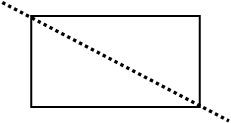

We welcome your feedback, comments and questions about this site or page. Please submit your feedback or enquiries via our Feedback page.
Reflection Symmetry
The simplest symmetry is Reflection Symmetry (sometimes called Line Symmetry or Mirror Symmetry ). It is easy to see, because one half is the reflection of the other half.
|
Here my dog "Flame" has her face The white line down the center is the |

The reflection in this lake also has symmetry, but in this case:
- the Line of Symmetry runs left-to-right
- it is not perfect symmetry, as the image is changed a little by the lake surface.
The Line of Symmetry can be in any direction (not just up-down or left-right). To learn more, go to Reflection Symmetry .
Rotational Symmetry
With Rotational Symmetry , the image is rotated (around a central point) so that it appears 2 or more times. How many times it appears is called the Order .
Here are some examples (they were made using Symmetry Artist , and you can try it yourself!)
| Order | Example Shape | Artwork |
|---|---|---|
Point Symmetry
Point Symmetry is when every part has a matching part:
- the same distance from the central point
- but in the opposite direction.
It is also the same as "Rotational Symmetry of Order 2" above
Symmetry is often in art, for example Rangoli is a type of art common in India:

Teach Starter, part of Tes Teach Starter, part of Tes
Search everything in all resources
Symmetry Worksheets
Updated: 06 Sep 2023
Use this set of eight symmetry worksheets to help students understand symmetry, the line of symmetry, and symmetrical objects.
Editable: Google Slides
Non-Editable: PDF
Pages: 2 Pages
- Curriculum Curriculum: CCSS, TEKS
Grades: 4 - 6
- PDF Boat (pdf) Sign up to Plus
- PDF Spider (pdf) Sign up to Plus
- PDF Castle (pdf) Sign up to Plus
- PDF Easter Bunny (pdf) Sign up to Plus
- PDF Easter Egg (pdf) Sign up to Plus
- PDF Flower (pdf) Sign up to Plus
- PDF Happy Face (pdf) Sign up to Plus
- PDF Star (pdf) Sign up to Plus
- Google Slides Sign up to Plus
Get inspired!
Tag #TeachStarter on Instagram for a chance to be featured!
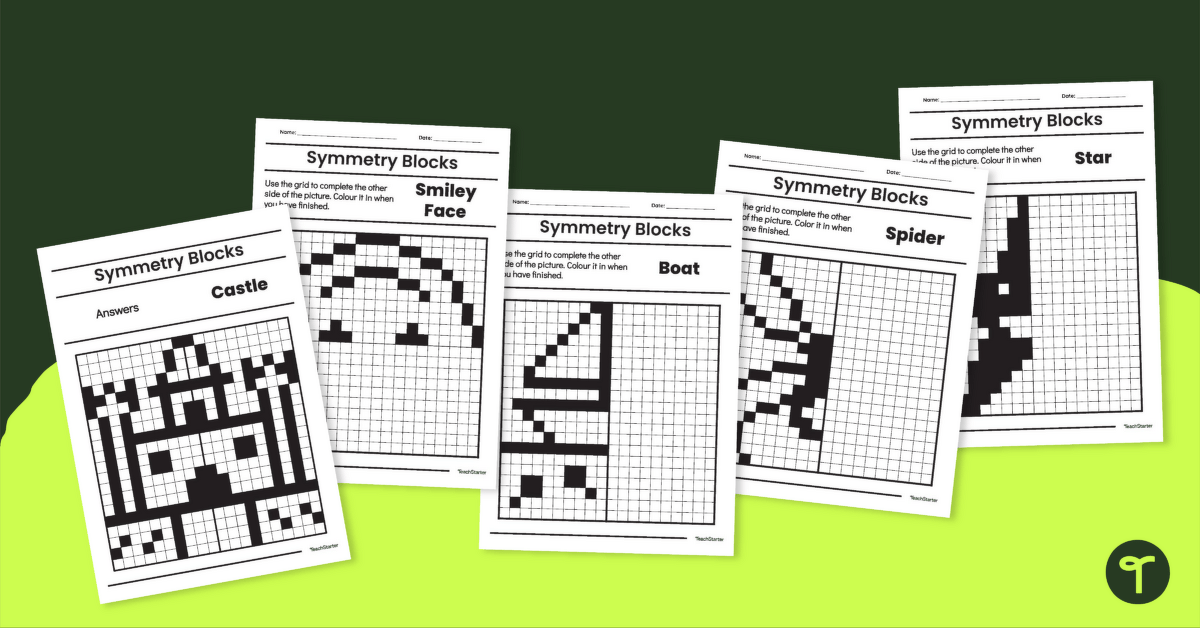
Symmetry Worksheets: Symmetry Art
The perfect way to explore symmetry is here! These symmetry worksheets are perfect for developing a student’s knowledge and understanding of lines of symmetry. Help students grasp this concept by showing them these shapes which, when ‘folded’ along their lines of symmetry, can be mirrored on the other side of the page.
These fun math worksheets allow students to use their critical thinking skills to complete the second half of a picture (the first half is already on the page for them!), following a grid on the page.
Encourage students to study the half-done drawing on the worksheet and imagine that a line running through the middle of the paper will split the drawing into two equal parts. Then your students can fill in the matching grid squares to create a reflection of the given pattern. This will reveal a mystery picture.
Symmetrical designs included in this pack are:
- Happy Face Emoji
Teacher tip: Teaching a theme? Perhaps it’s Halloween and you could use the Spider design to liven up your lessons! The Castle design would work well when teaching about fairytale narratives. The options for using this maths resource in your thematic unit are many!
Using these Symmetry Worksheets
Wondering how to get these fantastic symmetry worksheets into your busy planner? Why not:
- Include them as a math center or rotation activity
- Print some off and have them at hand in your fast-finisher box
- Send one home for a fun homework activity
- Set students the challenge of creating the most colorful design during Math class
- Use these as a mindful brain-break activity. Put on some quiet music and allow students to color and reflect at the same time.
Looking for more Symmetry Activities for Your Kids? We Have You Covered:
Teach Starter Publishing
We create premium quality, downloadable teaching resources for primary/elementary school teachers that make classrooms buzz!
Write a review to help other teachers and parents like yourself. If you'd like to request a change to this resource, or report an error, select the corresponding tab above.
Suggest a Change
Would you like something changed or customised on this resource? While our team makes every effort to complete change suggestions, we can't guarantee that every change will be completed.
Report an Error
Did you spot an error on this resource? Please let us know and we will fix it shortly.
Are you having trouble downloading or viewing this resource? Please try the following steps:
- Check that you are logged in to your account
- For premium resources, check that you have a paid subscription
- Check that you have installed Adobe Reader ( download here )
If you are still having difficulty, please visit the Teach Starter Help Desk or contact us .
You may also like
- Classroom Procedures →
- 2D Shapes →
- Halloween 2024 →
- Math Center Activities →
- Worksheets →
- Fall Activities →
- Early Finisher Activities →
- 4th Grade →
- 5th Grade →
- 6th Grade →
- Google Slide →
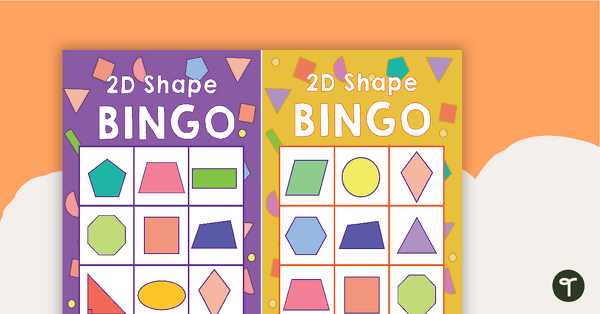
2-D Shape Bingo
Engage your students while consolidate learning about 2D shapes, their names and properties with 2D Shape Bingo!
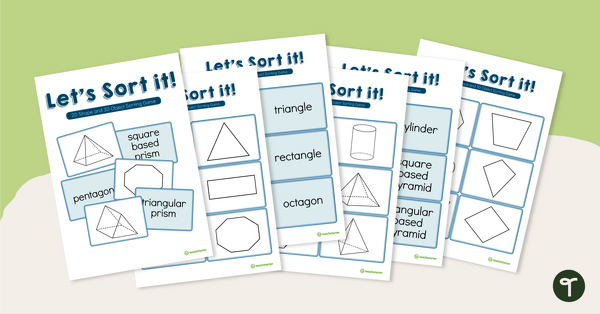
Let's Sort It! - 2D and 3D Shapes
Play this sorting game when learning about the properties of 2D and 3D shapes.

Individual 2-D Shapes Blue Print – Posters
2-D Shapes and their names, diagrams, and properties on individual posters.
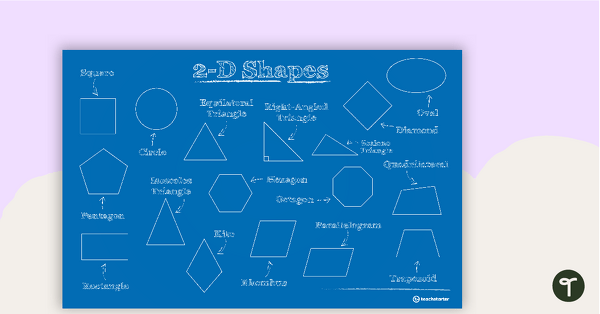
2-D Shapes – Poster
2-D shapes and their names on one poster.

2D and 3D Shapes Crossword with Solution
A crossword with clues for both 2D and 3D shapes.
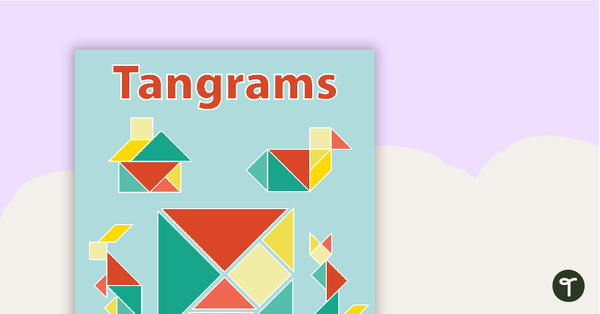
Tangram Activity
A poster showing examples of tangram shapes and a tangram template.

2-D Shapes Display Banner
A classroom display banner to use on your '2-D Shapes' display board.
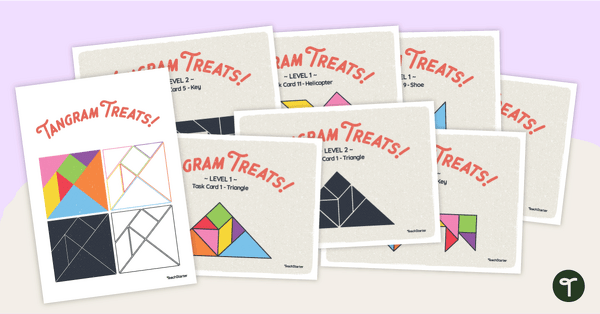
Tangram Treats - Tangram Puzzles
Have fun learning about shapes with a set of 36 tangram task cards separated into three levels, along with two tangram cut-out templates.
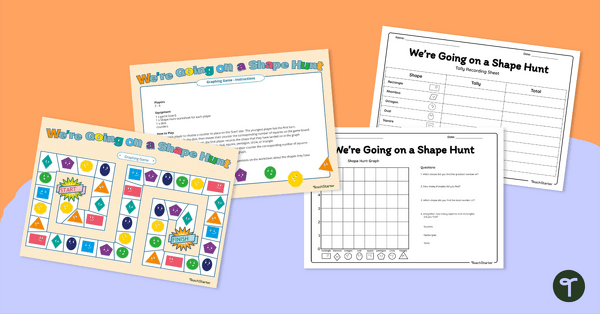
We're Going On a Shape Hunt! Graphing Game
Consolidate students' knowledge of 2D shapes while teaching about data collection, recording and graphing!
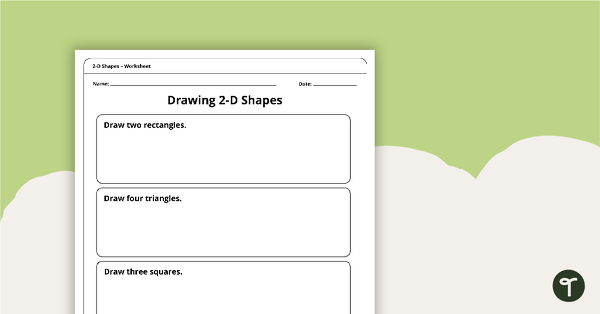
Drawing 2-D Shapes Worksheet
A worksheet asking students to draw specific 2-D shapes.

In our Symmetry lesson plan, students learn all about symmetry, including how it’s defined and how to determine if something is symmetrical. Students practice drawing lines of symmetry, identifying symmetric figures, and drawing a symmetrical second half for various figures.
Description
Additional information.
Our Symmetry lesson plan enables students to define symmetry, recognize a line of symmetry for a two-dimensional figure, identify line-symmetric figures and draw lines of symmetry. Engage critical thinking and generalize understanding as students explore the ways the human body is symmetrical and the reasons why it does not have perfect symmetry. During this lesson, students are asked to complete a fun, interactive activity in which they cut out shapes and fold them to find lines of symmetry, recording the number of lines of symmetry they can find for each shape. Students are also asked to circle letters which are symmetrical, draw a symmetrical other half of pictures and more.
At the end of the lesson, students will be able to define symmetry, recognize a line of symmetry for a two-dimensional figure, identify line-symmetric figures, and draw lines of symmetry.
| subject | Math |
|---|---|
| grade-level | 4th Grade, 5th Grade, 6th Grade |
| State Educational Standards | LB.Math.Content.4.G.A.3 |
Thank you for submitting a review!
Your input is very much appreciated. Share it with your friends so they can enjoy it too!
Practical and fun worksheets
This resource is ready to go and provides some simple practical and informative worksheets for classes.
Worked well
It worked great for my lesson.
Simple Symmetry
I really liked the material and activities provided in the Symmetry lesson. The shape activity allowed for hands-on experience in understanding line symmetry. The homework made my students open their eyes to examples of symmetry that they could find in their own homes and neighborhoods. The only issue I had, was with the answer key. The answer key appears to have included rotational symmetry in their answers for the shapes, but didn't mention rotational symmetry in the student instructions. My students were busily folding the shapes and didn't know to investigate rotational symmetry as well. Otherwise, a great product!
Great resources, thank you
Related products

Sports: Professional Wrestling

Sports: Ultimate

Sports: Disc Golf
Make your life easier with our lesson plans, stay up-to-date with new lessons.

- Lesson Plans
- For Teachers
© 2024 Learn Bright. All rights reserved. Terms and Conditions. Privacy Policy.
- Sign Up for Free
- Math Article
Symmetry And Line Of Symmetry: An Introduction

In geometry, symmetry is defined as a balanced and proportionate similarity that is found in two halves of an object. It means one-half is the mirror image of the other half. The imaginary line or axis along which you can fold a figure to obtain the symmetrical halves is called the line of symmetry .
If an object is symmetrical, it means that it is equal on both sides. Suppose, if we fold a paper such that half of the paper coincides with the other half of the paper, then the paper has symmetry.
Symmetry can be defined for both regular and irregular shapes. For example, a square is a regular (all sides are equal) and a rectangle is an irregular shape (since only opposite sides are equal). The symmetries for both shapes are different. Check different figures with symmetry here.
Symmetry in Mathematics
In Mathematics, a meaning of symmetry defines that one shape is exactly like the other shape when it is moved, rotated, or flipped. Consider an example, when you are told to cut out a ‘heart’ from a piece of paper, don’t you simply fold the paper, draw one-half of the heart at the fold and cut it out to find that the other half exactly matches the first half? The heart carved out is an example of symmetry.

Symmetry Math definition states that “symmetry is a mirror image”. When an image looks identical to the original image after the shape is being turned or flipped, then it is called symmetry. It exists in patterns. You may have often heard of the term ‘symmetry’ in day to day life. It is a balanced and proportionate similarity found in two halves of an object, that is, one-half is the mirror image of the other half. And a shape that is not symmetrical is referred to as asymmetrical. Symmetric objects are found all around us, in nature, architecture, and art.
Symmetrical Figures
Symmetrical shapes or figures are the objects where we can place a line such that the images on both sides of the line mirror each other. The below set of figures form symmetrical shapes when we place a plane or draw the lines.

For example, figure (b) has the symmetrical figures when we draw two lines of symmetry as shown below.

Line of Symmetry
The imaginary line or axis along which you fold a figure to obtain the symmetrical halves is called the line of symmetry. It basically divides an object into two mirror-image halves. The line of symmetry can be vertical, horizontal or diagonal. There may be one or more lines of symmetry.
1 Line Symmetry
Figure is symmetrical only about one axis. It may be horizontal or vertical. The word ATOYOTA has one axis of symmetry along the axis passing through Y.

2 Lines Symmetry
Figure is symmetrical with only about two lines. The lines may be ver tical and horizontal lines as viewed in the letters H and X. Thus, we can see here two lines symmetry .

3 Lines Symmetry
An example of three lines of symmetry is an equilateral triangle. Here, the mirror line passes from the vertex to the opposite side dividing the triangle into two equal right triangles.

4 Lines Symmetry
Four lines of symmetry can be seen in a square, that has all the sides equal.

Infinite lines
Some figures have not one or two, but infinite lines passing through the centre, and the figure is still symmetrical. Example: a circle.

Lines of Symmetry for Different Shapes
Learn below the number of lines of symmetry for different shapes.
- Lines Of Symmetry in a Parallelogram
- Lines of Symmetry in a Rectangle
- Rhombus Lines of Symmetry
Types of Symmetry
Symmetry may be viewed when you flip, slide or turn an object. There are four types of symmetry that can be observed in various situations, they are:
Translation Symmetry
Rotational symmetry.
- Reflection Symmetry
Glide Symmetry
If the object is translated or moved from one position to another, the same orientation in the forward and backward motion is called translational symmetry. In other words, it is defined as the sliding of an object about an axis. This can be observed clearly from the figure given below, where the shape is moved forward and backward in the same orientation by keeping the fixed axis.

When an object is rotated in a particular direction, around a point, then it is known as rotational symmetry or radial symmetry. Rotational symmetry existed when a shape turned, and the shape is identical to the origin. The angle of rotational symmetry is the smallest angle at which the figure can be rotated to coincide with itself. The order of symmetry is how the object coincides with itself when it is in rotation .
In geometry, many shapes consist of rotational symmetry. For example, the figures such as circle, square, rectangle have rotational symmetry. Rotational symmetry can also be found in nature, for instance, in the petals of a flower.
Below figure shows the rotational symmetry of a square along with the degree of rotation.

Click here for more information about rotational symmetry .
Reflexive Symmetry
Reflection symmetry is a type of symmetry in which one half of the object reflects the other half of the object. It is also called mirror symmetry or line of symmetry. A classic example of reflection symmetry can be observed in nature, as represented in the below figure.

Read more about reflection symmetry here.
The combination of both translation and reflection transformations is defined as the glide reflection. A glide reflection is commutative in nature. If we change the combination’s order, it will not alter the output of the glide reflection.
Symmetrical Shapes
The symmetry of shapes can be identified whether it is a line of symmetry, reflection or rotational based on the appearance of the shape.
The shapes can be regular or irregular. Based on their regularity, the shapes can have symmetry in different ways. Also, it is possible that some shapes does not have symmetry. For example, a tree may or may not have symmetry.
These can be better understood with the examples given below.
Solved Examples
Example 1: If the figure below follows a reflexive or line of symmetry, then complete the figure.

Given that, the figure has a line of symmetry.
That means, the second half (i.e. missing part) of the figure will be exactly the same as the given.
Thus, the complete figure is:

Example 2: Identify the shapes which do not have rotational symmetry from the below figure.

As we know, rotational symmetry is a type of symmetry, when we rotate a shape in a particular direction, the resultant shape is exactly the same as the original shape.
Thus, from the given figure (a) and (c) do not have a rotational symmetry.
A number of other kinds of symmetric types exist such as the point, translational, glide reflectional, helical, etc. which are beyond the scope of learning at this stage.
Watch The Below Video To Know More About Symmetry and Types of Symmetry
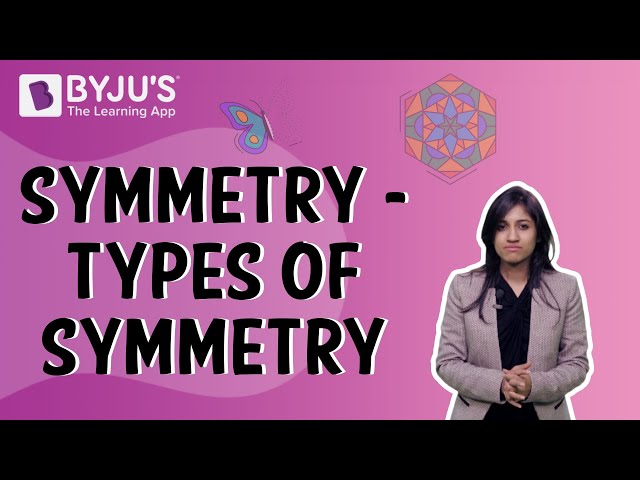
Download BYJU’S-The Learning App to learn with the help of personalised videos.
Frequently Asked Questions on Symmetry – FAQs
What is symmetry with example, what are the 4 types of symmetry, what is symmetric in math, why is symmetry in nature, can a line of symmetry be parallel.

Put your understanding of this concept to test by answering a few MCQs. Click ‘Start Quiz’ to begin!
Select the correct answer and click on the “Finish” button Check your score and answers at the end of the quiz
Visit BYJU’S for all Maths related queries and study materials
Your result is as below
Request OTP on Voice Call
| MATHS Related Links | |
Leave a Comment Cancel reply
Your Mobile number and Email id will not be published. Required fields are marked *
Post My Comment
Cleared all my doubts
This app is best learning app that clears all my doubts
it cleared all my doubts
It’s very nice
Register with BYJU'S & Download Free PDFs
Register with byju's & watch live videos.

Reading & Math for K-5
- Kindergarten
- Learning numbers
- Comparing numbers
- Place Value
- Roman numerals
- Subtraction
- Multiplication
- Order of operations
- Drills & practice
- Measurement
- Factoring & prime factors
- Proportions
- Shape & geometry
- Data & graphing
- Word problems
- Children's stories
- Leveled Stories
- Sentences & passages
- Context clues
- Cause & effect
- Compare & contrast
- Fact vs. fiction
- Fact vs. opinion
- Main idea & details
- Story elements
- Conclusions & inferences
- Sounds & phonics
- Words & vocabulary
- Reading comprehension
- Early writing
- Numbers & counting
- Simple math
- Social skills
- Other activities
- Dolch sight words
- Fry sight words
- Multiple meaning words
- Prefixes & suffixes
- Vocabulary cards
- Other parts of speech
- Punctuation
- Capitalization
- Narrative writing
- Opinion writing
- Informative writing
- Cursive alphabet
- Cursive letters
- Cursive letter joins
- Cursive words
- Cursive sentences
- Cursive passages
- Grammar & Writing
Breadcrumbs
Lines of symmetry

Download & Print Only $6.50
Mirror images
A line of symmetry divides a figure into two mirror-image halves. In these geometry worksheets, students identify and draw lines of symmetry and symmetrical shapes .

Identify symmetrical shapes:
Lines of symmetry:
Draw symmetrical shapes:

These worksheets are available to members only.
Join K5 to save time, skip ads and access more content. Learn More
What is K5?
K5 Learning offers free worksheets , flashcards and inexpensive workbooks for kids in kindergarten to grade 5. Become a member to access additional content and skip ads.
Our members helped us give away millions of worksheets last year.
We provide free educational materials to parents and teachers in over 100 countries. If you can, please consider purchasing a membership ($24/year) to support our efforts.
Members skip ads and access exclusive features.
Learn about member benefits
This content is available to members only.
- Forgot Password?
If you're seeing this message, it means we're having trouble loading external resources on our website.
If you're behind a web filter, please make sure that the domains *.kastatic.org and *.kasandbox.org are unblocked.
To log in and use all the features of Khan Academy, please enable JavaScript in your browser.
AP®︎/College Art History
Course: ap®︎/college art history > unit 1, balance, symmetry, and emphasis.
- Proportion and scale
- Pattern, repetition and rhythm, variety and unity
Balance and symmetry
Radial symmetry, asymmetrical balance, want to join the conversation.
- Upvote Button navigates to signup page
- Downvote Button navigates to signup page
- Flag Button navigates to signup page

IMAGES
VIDEO
COMMENTS
Symmetry Worksheets. Symmetry worksheets consist of a variety of skills for children in grade 1 through grade 5 to understand the lines of symmetry in different shapes. Printable exercises to identify and draw the lines of symmetry, complete the shapes, count the lines of symmetry in each shape, to identify symmetrical or asymmetrical shapes ...
Line Symmetry Worksheets. On this webpage you will find our range of line symmetry sheets for kids. The sheets have been carefully graded with the easier sheets coming first. The first 3 worksheets involve only horizontal and vertical lines only. The next 3 worksheets involve reflecting diagonal lines as well.
3 Draw a horizontal line through the marked center and check for line symmetry. 4 Draw a line from each vertex through the center and check for line symmetry. 5 State the number of lines of symmetry. The equilateral triangle has 3 lines of symmetry. An equilateral triangle has 3 equal sides and 3 equal angles, so it will have 3 lines of symmetry.
Symmetrical shapes worksheets. A line of symmetry divides a shape into identical halves. In these worksheets, students identify symmetrical shapes and draw lines of symmetry. Draw the lines of symmetry: Worksheet #1 Worksheet #2. Worksheet #3. Complete the symmetrical drawing: Worksheet #4 Worksheet #5. Worksheet #6 Worksheet #7.
Use the line of symmetry, represented by the dashed line, to complete each figure. The figure below is a circle. How many lines of symmetry does the figure have? Explain. Show Video Lesson. NYS Math Module 4 Grade 4 Lesson 12 Homework. Circle the figures that have a correct line of symmetry drawn. Find and draw all lines of symmetry for the ...
Includes worksheets the require students to draw lines of symmetry, determine which pictures are symmetrical, and design symmetrical illustrations. Symmetry Worksheet FREE. Part 1: Tell whether the dotted lines on the shapes are lines of symmetry. Part 2: draw lines of symmetry on the shapes.Part 3: draw the second half of each symmetrical figure.
1. Symmetry Art Swap. For this activity, you'll want to provide individuals with graph paper and art supplies. Every student will begin by creating a "line of symmetry," preferably horizontal or vertical to begin with, through the center of the page. Then, they can create a geometric design of their liking on ONE side of the mirror line.
Identify line symmetry. Draw a line of symmetry through the triangle by connecting two black points. Learn for free about math, art, computer programming, economics, physics, chemistry, biology, medicine, finance, history, and more. Khan Academy is a nonprofit with the mission of providing a free, world-class education for anyone, anywhere.
Videos, examples, solutions, and lessons to help Grade 4 students learn to recognize a line of symmetry for a two-dimensional figure as a line across the figure such that the figure can be folded along the line into matching parts. Identify line-symmetric figures and draw lines of symmetry. Common Core: 4.G.3.
The lines of symmetry. Let our Lines of Symmetry resource mirror your pupils' needs with an accurate line of information a great range of tasks! Complete the Lines of Symmetry worksheet together in the classroom or set it as homework / home learning. Either way, both sides are catered for thanks to a thorough introductory section that guides ...
The simplest symmetry is Reflection Symmetry (sometimes called Line Symmetry or Mirror Symmetry ). It is easy to see, because one half is the reflection of the other half. of photo magic. The reflection in this lake also has symmetry, but in this case: it is not perfect symmetry, as the image is changed a little by the lake surface. The Line of ...
These symmetry worksheets are perfect for developing a student's knowledge and understanding of lines of symmetry. Help students grasp this concept by showing them these shapes which, when 'folded' along their lines of symmetry, can be mirrored on the other side of the page. ... Send one home for a fun homework activity; Set students the ...
Simple Symmetry. I really liked the material and activities provided in the Symmetry lesson. The shape activity allowed for hands-on experience in understanding line symmetry. The homework made my students open their eyes to examples of symmetry that they could find in their own homes and neighborhoods. The only issue I had, was with the answer ...
A 2D shape is symmetrical if a line can be drawn through it so that either side of the line looks exactly the same. You can also define symmetry at KS2 by saying that something is symmetrical when it is the same on both sides. A shape has symmetry if a central dividing line (that we often call a mirror line) can be drawn on it, to show that ...
This Symmetry Games, Worksheets and Activities Pack includes a range of Lines of Symmetry KS1 worksheets that will help test your students' knowledge of measurement, geometry, and lines of symmetry. This pack includes a collection of symmetry exercises that require students to complete images by drawing the remaining symmetrical half of the picture. There is a large collection of pictures to ...
In geometry, symmetry is defined as a balanced and proportionate similarity that is found in two halves of an object. It means one-half is the mirror image of the other half. The imaginary line or axis along which you can fold a figure to obtain the symmetrical halves is called the line of symmetry. If an object is symmetrical, it means that it ...
Symmetry Homework Session 7, Homework. The coordinate geometry that you first worked with in Session 6 is useful for describing transformations. Before looking at how that works, here are a few problems with coordinates to get you warmed up. ... Session 7 Symmetry. Investigate symmetry, one of the most important ideas in mathematics. Explore ...
Homework. Symmetry is one of the most important ideas in mathematics. There can be symmetry in an algebraic calculation, in a proof, or in a geometric design. It's such a powerful idea that when it's used in solving a problem, we say that we exploit the symmetry of the situation. In this session, you will explore geometric versions of ...
Mirror images. A line of symmetry divides a figure into two mirror-image halves. In these geometry worksheets, students identify and draw lines of symmetry and symmetrical shapes. Identify symmetrical shapes: Worksheet #1. Lines of symmetry: Worksheet #2. Draw symmetrical shapes: Worksheet #3.
The ratio of the lengths of two corresponding sides of two similar polygons or two similar solids. A point which is outside of a figure. f (x) is substituted for the variable y when the equation is solved for y. Example: f (x) = 3x - 4. Study with Quizlet and memorize flashcards containing terms like Line of Symmetry, Rotational Symmetry ...
Homework/Extension - Lines of Symmetry - Year 2 Developing. 4.Jack has cut shapes in half along their vertical lines of symmetry. Match the halves. Homework/Extension - Lines of Symmetry - Year 2 Expected. 7.Francis has cut shapes along their horizontal and vertical lines of symmetry. Match the parts to their whole. GD.
Find out more about symmetrical 2D shapes. KS2 Symmetry learning resources for adults, children, parents and teachers.
Balance is an even use of elements throughout a work of art. Symmetry is a very formal type of balance consisting of a mirroring of portions of an image. Bilateral symmetry, that is, two- sided symmetry, is the most common, in which two halves of a work of art mirror each other, as in Perugino's painting, Christ Giving the Keys of the Kingdom ...